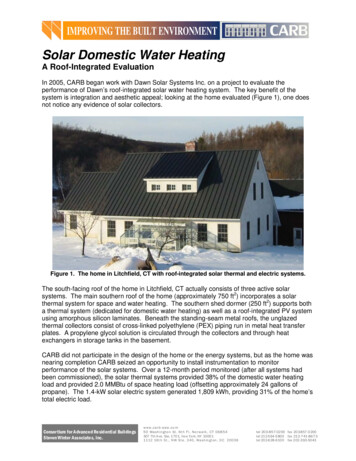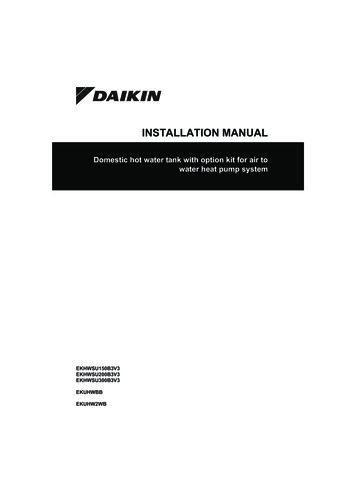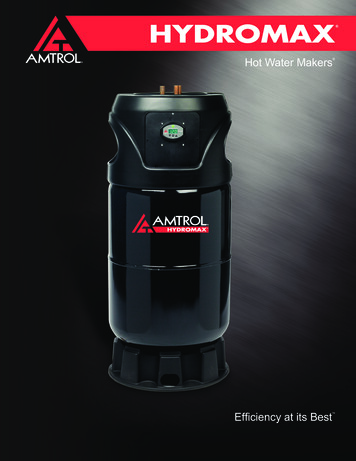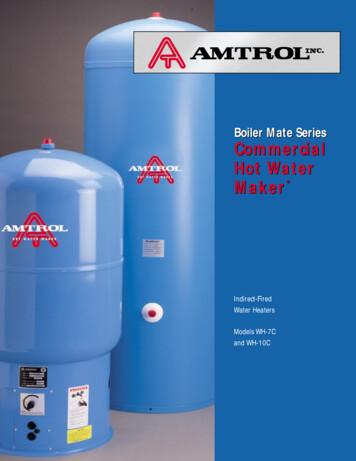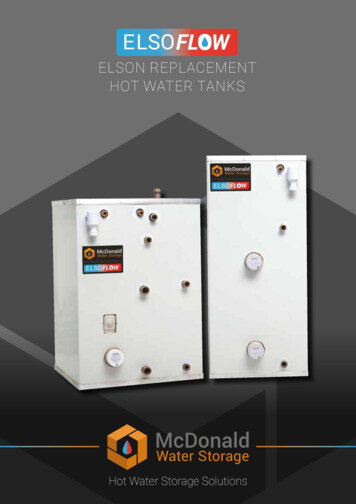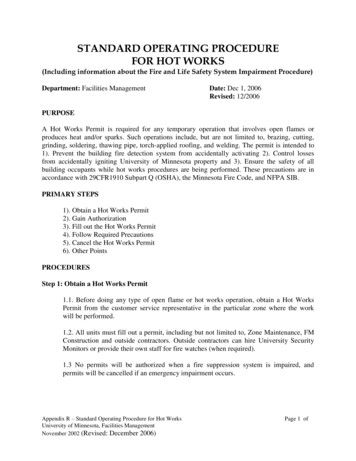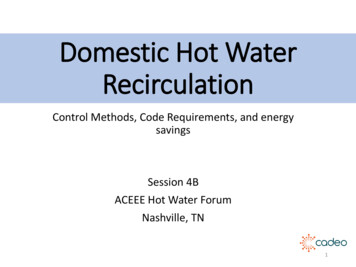
Transcription
Domestic Hot WaterRecirculationControl Methods, Code Requirements, and energysavingsSession 4BACEEE Hot Water ForumNashville, TN1
Domestic Hot Water RecirculationWhy am I talking to you about controls on DHW RecirculationloopsNEEA’s Extended Motor Products Initiative Aimed at improving the efficiency of pumps and pumpsystems in the Pacific Northwest The Regional Technical Forum (RTF) has developed“Planning Measures” for C&I Pumps and Circulators They will expire if they are not validatedNEEA is pursuing research, with assistance from PG&E, to verifyand improve the savings estimates and convert them to Provenmeasures The Energy Savings associated with DHW Circulators isheavily dependent on the control strategy that isemployed We are research control strategies, and incorporatingprevious research into the sampleNote: the RegionalTechnical Forum is aregional body in thePNW that reviews andapproves energyefficiency savings onbehalf of the region. Formore info, see:https://rtf.nwcouncil.org2
Agenda Control Methods for DHW Circulation Review Code requirements for these systems Focused on On-Demand control Discuss the Energy Savings that previous studieshave seen by employing these controls The effectiveness of these controls3
DHW Recirculation Control Strategies No Control Timer Control Temperature Control Learning Mode On Demand Control Temperature Modulation4
DHW Recirculation Control Strategies No Control 24/7 Pump operation No change in temperature setpoint Least energy efficient option Pump operating 24/7 Water heater has to make up for loop losses 24/7 Constantly loosing energy to the building, HVAC System iscompensating Not Allowed by code in many area5
DHW Recirculation Control Strategies Timer Control Schedule the recirc pump to operate when most of theinstances of water use occurPump OperationPump Status10.506
DHW Recirculation Control Strategies Temperature control When the temperature of the water in the line dropsbelow a certain set-point the pump turns on until thetemperature in the line reaches an upper set point.TemperatureTemperature Control7Controller LimitWater Temperature
DHW Recirculation Control Strategies Learning Mode A period of time is taken to monitor the use patterns ofthe occupants and then the pump schedule is set tooperate across these time periods8
DHW Recirculation Control Strategies Temperature Modulation The temperature of the Hot Water is varied based onoccupancy patterns in the building (increase thetemperature during the highest use periods, decreasethe temperature during the lowest use periods) Pump operates 24/7 in this instance9
DHW Recirculation Control Strategies Combination Controls Utilizing multiple control schemes, like On-DemandControl Temperature modulation can prove to be aneffective way to decrease energy consumption Temperature control Timer10
DHW Recirculation Control Strategies On-Demand Control This control method is required by code in many areas This control strategy uses a demand for water/call forwater to start the recirculation pump. What qualifies as a call for water Physically pushing a button to call for water Motion sensor detecting presence at the water fixture Change in Make-up water flow rate, indicating water use11
DHW Recirculation Control Strategies No Control Timer Control Temperature Control Learning Mode On Demand Control Temperature Modulation12
Code RequirementsCode Definition for Circulation Systems Circulating Hot Water SystemInternational Plumbing Code “A specifically designed water distribution system whereone or more pumps are operated in the service hotwater piping to circulate heated water from the waterheating equipment to fixture supply and back to thewater-heating equipment”13
Code RequirementsCode Definition for Demand Control Recirculation Systems Demand Recirculation Water SystemInternational Plumbing Code “A water distribution system where one or more pumpsprime the service hot water piping with heated water upon ademand for hot water”IECC “A water distribution system having one or more recirculationpumps that pump water from a heated water supply pipeback to the heated water source through a cold water supplypipe”14
Code Requirements for DWH ControlsDifferent versions of the energy code have different requirements for DHWRecirculation15 Energy Codes lump Multi-family in with Commercial* All
Code Requirements for DWH ControlsIECC has different requirements depending on the versionIECC 2009“Automatic-CirculatingHot Water SystemPumps shall bearranged to beconveniently turned offautomatically ormanually when hotwater system is not inuse”16 Doesn’t require a pump on arecirculation system Can be turned off automatically ormanually “Conveniently turned off”
Code Requirements for DWH ControlsIECC has different requirements depending on the versionIECC 2012“Circulating hot watersystem pumps shall bearranged to be turnedoff either automaticallyor manually when thereis limited hot waterdemand. Ready accessshall be provided to theoperating controls”17 Doesn’t require a pump on arecirculation system “Limited hot water demand” Can be turned off automatically ormanually Requires “Ready access” to controls
Code Requirements for DWH ControlsIECC has different requirements depending on the versionIECC 2015“Circulation systems shall beprovided with a circulationpump .Controls for circulatingsystem pumps shall start thepump based on theidentification of a demand forhot water . The controls shallautomatically turn off the pumpwhen the water in thecirculation loop is at the desiredtemperature and there is nodemand for hot water ”18 Requires a pump on a circulationsystem Demand-start required Automatic pump stop required When the circulation loop is “atthe desired temperature andthere is no demand for hotwater”
Code Requirements for DWH ControlsIECC has different requirements depending on the versionIECC 2009“Automatic-Circulating HotWater System Pumps shallbe arranged to beconveniently turned offautomatically or manuallywhen hot water system isnot in use”19IECC 2012“Circulating hot watersystem pumps shall bearranged to be turned offeither automatically ormanually when there islimited hot water demand.Ready access shall beprovided to the operatingcontrols”Code becomes more explicitIECC 2015“Circulation systems shall beprovided with a circulationpump .Controls for circulatingsystem pumps shall start thepump based on theidentification of a demand forhot water . The controls shallautomatically turn off the pumpwhen the water in thecirculation loop is at the desiredtemperature and there is nodemand for hot water ”
Code Requirements for DWH ControlsCalifornia, Washington, and Massachusetts have state-specificrequirementsCalifornia“ hot water systems with circulating pumps or with electricalheat trace shall be capable of automatically turning off thesystemWashington“Heated water circulation systems shall be provided with a circulation pump .Controls for circulating hot water pumps shall start the pump based on identificationof a demand for hot water .The controls shall automatically turn off the pump whenthe water in the circulating loop is at the desired temperature and when there is nodemand for hot water”MassachusettsRefers to IECC 200920
Demand Controls, as defined by CodeOur general understanding of the Code definition of DemandControlThe control shall start the pump upon receiving a signalfrom the action of a user or a fixture or appliance,sensing the presence of a user or a fixture or sensing theflow of hot or tempered water to a fixture fitting orappliance. Meaning Push-Button Demand Control Motion Sensing Demand control (integrated into lightingmotion sensors? Nest Thermostats?) Indication of flow, installed on recirculation loop Include different examples of such (not necessarily “flow”) Doesn’t include21 ?
What Strategies work best inMF/Commercial BuildingsMost current research in the commercial and multifamily sectors focuson 1 or 2 control strategies Research on Demand Control dominates thecurrent body of work The coupling of controls (Demand TempModulation) is common Learning controls are not prevalent in the currentresearch22
Demonstrated SavingsEnergy Savings seen in research from DHW Recirculation ControlsOrganizationThe Levy PartnershipHeshong Mahone GroupMN Center for Energy andEnvironmentBenningfield GroupOracle America, IncEnovative Case Study23Buildings TypeControl MethodPump SavingsWater Heater SavingsMultifamilyDemandTemperature Modulation1,708-2,602 kWh/yearNA6-12%2-8%Demand TM1,708-2,602 nMultifamilyCommercialMultifamilyDemand ControlAverage of 11%Timer ControlAverage of 1%Temperature ModulationAverage of 11.40%DemandAverage of 1,236 kWh/year Average 1,526 therms/buildingTimer43%*27%Demand78%30%
Effectiveness of DHW RecirculationControls Make sure the controls fit the Application You wont get savings if End Users aren’t getting hotwater and override the controls For large loops the controls have to keep the loop warm Temperature-based controls Schedule based controls work if you can confidently predict thewater usage schedule24
Thank you25
How can we better implement occupancybased controls in MF/Commercial Focusing on one control method as a “Silver Bullet”for the entire MF/Commercial sectors is not goingto work26
Legionnaires Disease and DHW RecirculationThe language in the OSHA Code referring to Constant Recirculation is a recommendation, and bettermethods of managing Legionella growth are available in Multifamily and Commercial Buildings OSHA General Safety and Health Provisions recommend constant recirculation ofDHW. (29 CFR 1926.32) This is to prevent the proliferation of Legionella in the water system. DHW Systems in Commercial Buildings rarely sit idle long enough for growth tooccur in the trunk lines. Major issues are dead legs and underused portions ofthe system. Developing and implementing a comprehensive Water Safety Plan is a moreeffective way to prevent LD. Is building and site specific, looks at the piping layout, the mechanical system, andoperational habits27
Controls for circulating hot water pumps shall start the pump based on identification of a demand for hot water .The controls shall automatically turn off the pump when the water in the circulating loop is at the desired temperature and when there is no demand for hot water" Washington. Massachusetts. Refers to IECC 2009



